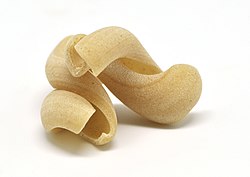Strozzapreti
This article needs additional citations for verification. (November 2007) |
 Uncooked strozzapreti | |
| Type | Pasta |
|---|---|
| Place of origin | Italy |
Strozzapreti (Italian pronunciation: [ˌstrɔttsaˈprɛːti]; "priest-choker" or "priest-strangler"[1]: 152 [2] in Italian) are an elongated form of cavatelli, or hand-rolled pasta typical of the Emilia-Romagna, Tuscany, Marche and Umbria regions of Italy as well as in the state of San Marino. The name is also used for a baked cheese and vegetable dumpling, prepared in some regions of Italy and on the French island of Corsica.
Origin of name[]
This section does not cite any sources. (November 2014) |
There are several legends to explain the name, primarily based on the anticlerical sentiment of the region.
One is that gluttonous priests were so enthralled by the savory pasta that they ate too quickly and choked themselves.[1] Another explanation involves the "azdora" ("housewife" in the Romagna dialect), who "chokes" the dough strips to make the strozzapreti. The azdora would express rage (perhaps triggered by the misery and difficulties of her life) and curse the local clergy, resulting in a pasta that could choke a priest. A third states that wives would customarily make the pasta for churchmen as partial payment for land rents (In Romagna, the Catholic Church had extensive land properties rented to farmers), and their husbands would be angered enough by the venal priests eating their wives' food to wish the priests would choke as they stuffed their mouths with it. The name surely reflects the diffuse anticlericalism of the people of Romagna and Tuscany.
Another possible explanation is that following Sunday mass, it was common for the priest to visit homes of the villagers and enjoy dinner with them. The more pleasant experiences for the priest would entice them to come back to that particular home more frequently. As a means for the family to let the priest know that he might be overextending his welcome, they would serve this pasta which had later earned the name "Strozzapreti." Another origin story is that the pasta resembles a clerical collar, commonly referred to as a "Priest Choker".
Pasta description[]
The dough (see some regional variations below) is rolled out in thick flat sheets. It is then cut into strips. The strips are lightly rolled or twisted between the palms. The large pasta is separated into 10 cm pieces by pinching. Unlike spaghetti or macaroni, this pasta is not uniform in size or shape.
The dough traditionally used for strozzapreti in Romagna is made with wheat flour, water, salt, and (optionally) eggs.
In Emilia the dough is made from flour, water, Parmesan cheese, and egg whites, all beaten together.
Pici is a somewhat similar form of pasta from Tuscany in which hand-rolled, solid fat tubes of dough are cut but left untwisted; the taut, rope-like appearance provides yet another popular explanation for the association with strangling.
Corsican Strozzapreti[]
Strozzapreti (Corsican: sturzapreti) refers also to large gnocchi made of cheese and vegetables, and then baked, typical of Corsica. Seasoned spinach or chard is rolled into balls together with brocciu cheese, and then baked in the oven. These balls are large enough to choke a person if eaten whole.[3]
References[]
- ^ a b Gavin, Paola (1994). Italian Vegetarian Cooking. Rowman & Littlefield. ISBN 9780871317698.
- ^ "Strozza" is third person singular indicative of "strozzare"
- ^ "Priest Chokers". www.alacartetv.com. Retrieved Oct 17, 2019.
- Types of pasta
- Cuisine of Emilia-Romagna
- Cuisine of Umbria